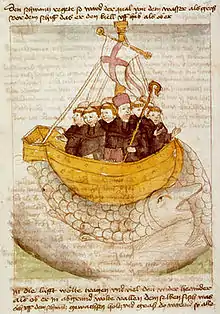Hafgufa
Hafgufa (Icelandic, haf "sea" + gufa "steam") is the name of a massive sea monster reported in the Örvar-Odds saga to have existed in the Greenland Sea which was said to disguise itself as an island or pair of rocks rising from the sea.
| Grouping | Legendary creature |
|---|---|
| Sub grouping | Sea monster |
| Other name(s) | Hafgufu (Old Norwegian) |
| Country | Greenland |
Norway
In Konungs skuggsjá, an Old Norwegian philosophical didactic work written toward the end of the 12th century, the King told his son of several whales that inhabit the Icelandic seas, concluding with a description of a large whale that he himself feared, but he doubted anyone would believe him about without seeing it. He described the Hafgufa (Hafgufu in Old Norwegian language) as a massive fish that looked more like an island than like a living thing. The King noted that Hafgufa was rarely seen, but always seen in the same two places. He concluded there must be only two of them and that they must be infertile, otherwise the seas would be full of them.
The King described the feeding manner of Hafgufa: The fish would belch, which would expel so much food that it would attract all the nearby fish. Once a large number had crowded into its mouth and belly, it would close its mouth and devour them all at once.[1]
Iceland
According to the Örvar-Odds saga, Hafgufa was the mother of all sea monsters and fed on whales, ships, men, and anything it could catch. Hafgufa was said to have lived underwater, and when the tide was low at night, her nose and head would rise out of the water. The only physical description provided in the saga is the nose sticking out of the water, which was mistaken for two massive rocks rising from the sea.
As Örvar-Oddr and his crew were sailing southwesterly through the Greenland Sea seeking vengeance against the troll Ögmundr Floki, slayer of Eythjof, the deck officer Vignir knew this area would be dangerous, and made Oddr agree to sail the ship beginning the next day, to which Oddr requested Vignir advise him. As they sailed, they spotted two rocks which rose out of the water. The presence of these rocks puzzled Oddr. Later, they passed by a large island covered in heather. Curious, Oddr made up his mind to turn back and send five men to check out the island, but as they approached where the island had been before, they saw that it and the two rocks vanished.
Vignir explained to Oddr that, had they landed sooner, the crew would have surely drowned. The "rocks" and "island" must have been two sea monsters—the great whale Lyngbakr, and Hafgufa. The rocks had surely been the nose of Hafgufa; the island, Lyngbakr; and Ögmundr had surely summoned the beasts to kill Oddr and his men.[2]
Likenings to other sea monsters

The 17th-century Danish physician Thomas Bartholin once published in a journal that he recalled having heard about St. Brendan saying Mass obliviously atop Hafgufa (he was either mistaken or misinformed; or possibly interpreted it with his own local gloss; the correct beast in this legend was the giant fish Jasconius).[3][4] Later, William Blackwood and Laurence Marcellus Larson presumed the beasts mentioned in the konungs skuggsjá, St. Brendan's saga, and several other sea monster sightings must have been what they knew as the kraken.[5][6]
References
- Konungs skuggsjá (in Norwegian).
- "Örvar-Odds" (in Icelandic).
- Bartholin, T. Historiarum Anatomicarum Rariorum Centuria. 4. As cited in Blackwood, W. (1818). "Remarks on the histories of the kraken and great sea serpent". Blackwood's Magazine. 2:645-654. (in Latin)
- C. R. Unger. (1877). "Brandanus saga (fragment)". Translated from the original Latin to Icelandic. Heilagra manna søgur: Fortællinger og legender om hellige mænd og kvinder. 272-275. (in Icelandic)
- Blackwood, W.. (1818). "Remarks on the histories of the kraken and great sea serpent". Blackwood's Magazine. 2:645-654.
- Larson, L.M. (1917). "The king's mirror (speculum regale konungs skuggsjá) translated from the Old Norwegian".